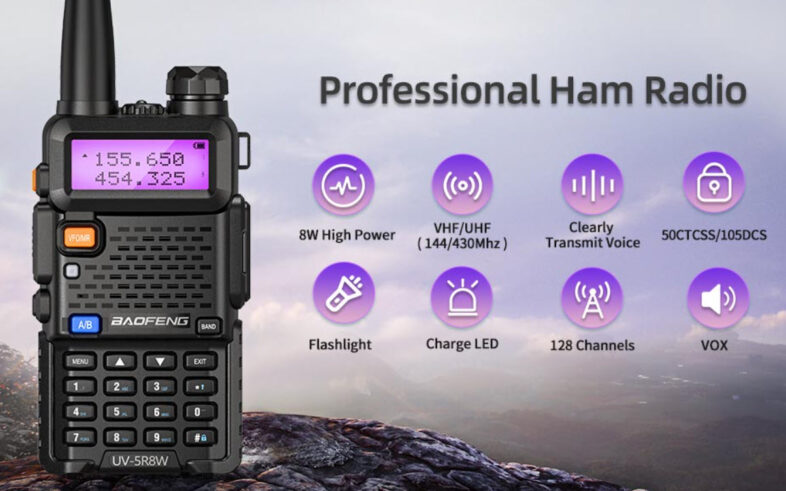Guide to Ham Radio for Emergency Communication for Beginners
If you are read to stop relying on the unreliable cell phone service in an emergency, then its time to check out a Ham radio for communication. Start with a the above Ham Radio Bible, and read on to learn more.
This guide is your ticket to understanding the world of ham radio, a powerful communication tool that offers unmatched reliability in times of crisis. Say goodbye to dropped calls and spotty reception as you embark on a journey to become proficient in this vital skill.
What is Ham Radio Communication?
Above is the PRESIDENT MCKINLEY USA SSB 12/24V CB Radio available on Amazon!
Ham radio communication, or amateur radio, is a means of communication that allows individuals to communicate with each other using radio frequencies.
Unlike traditional forms of communication, such as telephones or the internet, ham radio communication operates through the use of transceivers. These devices can both transmit and receive radio signals which is essential for communication in an emergency.
This form of communication has been around for many decades and has its origins in the early days of wireless telegraphy.
Understanding the Basics of Ham Radio Communication
To fully grasp the concept of ham radio communication, it is essential to understand the basics. At its core, ham radio communication involves the use of licensed radio operators who operate amateur radio stations. These stations are equipped with transceivers, antennas, and other necessary equipment to facilitate communication.
Check out the Ham Radios on Amazon today!
One key distinction of ham radio communication is its non-commercial nature. Unlike commercial radio stations, ham radio operators are not allowed to transmit signals for financial gain. Instead, ham radio communication focuses on fostering interpersonal connections, building communities, and providing a crucial means of communication during emergencies.
History of Ham Radio
The history of ham radio can be traced back to the late 19th century, when inventors and enthusiasts began experimenting with wireless telegraphy. Early pioneers, such as Guglielmo Marconi and Nikola Tesla, played a significant role in the development of wireless communication technologies, which laid the foundation for ham radio as we know it today.
In the early 20th century, amateur radio operators started emerging, and during World War I, they became valuable assets in supporting military communications. These operators played a vital role in relaying information, monitoring enemy transmissions, and providing a network of communication during wartime.
Since then, ham radio has continued to evolve and has become a popular hobby for many individuals worldwide. It has also maintained its importance in emergency communication, providing a reliable alternative when traditional communication infrastructure fails.
Importance of Ham Radio in Emergency Communication
One of the most critical aspects of ham radio communication is its role in emergency situations. When disasters strike, conventional communication methods such as landlines, cell phones, and the internet often become unreliable or even non-functional. In these situations, ham radio operators are uniquely positioned to provide a lifeline of communication.
Transmit Signals
Ham radio’s ability to transmit signals over long distances, sometimes spanning continents, makes it a powerful tool during emergencies. In times of natural disasters or other crises, ham radio operators can relay vital information, coordinate rescue efforts, and provide a means for affected individuals to communicate with their loved ones.
The decentralized and self-sufficient nature of ham radio also ensures that communication networks can be quickly established, even in areas where infrastructure has been severely damaged or destroyed. The resilience of ham radio makes it invaluable to communities and emergency response organizations around the world.
Ham Radio Baofeng UV-5R 8W High Power Dual Band Two Way with Handheld Speaker Mic and AR-771 Antenna 2Pack
Begin with Ham Radio
Before diving into the world of ham radio, it is essential to gather the necessary equipment and obtain the required licenses. Here are some key steps to get started:
Choosing the Right Ham Radio Equipment
Selecting the appropriate ham radio equipment is crucial for a successful experience. There are various types of transceivers available, ranging from handheld radios for portable use to more advanced base stations with greater power and features. It is essential to consider factors such as your budget, intended use, and the frequency bands you wish to operate on when making this decision.
Understanding Frequency Bands
Ham radio communication operates within different frequency bands, each with its unique characteristics and regulations. Familiarize yourself with the frequency bands allocated to amateur radio operators in your region and the modes of communication permitted within each band. This knowledge will help you choose suitable equipment and ensure compliance with legal requirements.
Licensing Requirements for Ham Radio Operators
To legally operate ham radio equipment, you must obtain an amateur radio license. The licensing process typically involves passing an examination to demonstrate knowledge of regulations, operating procedures, and technical concepts. Check with your country’s regulatory authority or amateur radio association for specific licensing requirements in your region.
Setting Up Your Ham Radio Station
Once you have the necessary equipment and licenses, it’s time to set up your ham radio station. Consider the following aspects:
Antennas and their Types
The choice and proper installation of antennas greatly impact the performance of your ham radio station. Different types of antennas, such as vertical antennas, dipole antennas, and Yagi antennas, serve various purposes and excel in specific frequency bands. Research the characteristics of each type and select one that suits your needs and available space.
Selecting a Suitable Location
The location of your radio station plays a significant role in maximizing signal quality and minimizing interference. Choose a spot with minimal obstructions, such as tall buildings or trees. Avoid locations near power lines or other sources of electromagnetic interference. Install your antennas at an elevated position whenever possible to enhance signal propagation.
Installing and Grounding Equipment
Proper installation and grounding of your ham radio equipment are crucial for safety and optimal performance. Follow manufacturer guidelines and best practices when connecting and securing cables, antennas, and grounding systems. Consult a licensed electrician if needed to ensure compliance with electrical codes and standards.
Learn the Ham Radio Lingo
To effectively communicate in the ham radio community, it is essential to familiarize yourself with the lingo commonly used. Here are some key aspects to focus on:
Understanding Q-Codes and their Meanings
Q-Codes are three-letter codes that carry specific meanings and are widely used in ham radio communication. Learning commonly used Q-Codes, such as QSO (a general call for conversation), QRM (radio interference), and QTH (location), will enable you to effectively communicate and understand others on the airwaves.
Familiarizing with Phonetic Alphabets
In situations where clarity is vital, such as when spelling words or providing call signs, ham radio operators use phonetic alphabets to ensure accurate transmission and reception. The most commonly used phonetic alphabet in ham radio is the International Radiotelephony Spelling Alphabet (Alpha, Bravo, Charlie, etc.). Practice using this alphabet to enhance your communication skills.
Essential Abbreviations and Acronyms
There are numerous abbreviations and acronyms utilized in ham radio communication. These shortcuts facilitate efficient and concise communication. Examples of common abbreviations include RST (a signal report system) and QSL (confirmation of receipt). Familiarize yourself with frequently used abbreviations to streamline your conversations.
Operating Procedures and Etiquettes
When engaging in ham radio communication, adhering to proper operating procedures and etiquettes is essential to maintain a harmonious and effective communication environment. Consider the following guidelines:
Calling and Answering a Ham Radio Station
When calling another ham radio station, use standardized calling procedures and protocols. Establish your callsign, the callsign of the station you want to contact, and the nature of your communication. Use clear and concise language, and avoid unnecessary conversation or interference.
Practice Good Radio Etiquette
Maintain good radio etiquette by allowing other operators to finish their transmissions before initiating your own. Listen carefully before transmitting to ensure you are not interrupting ongoing conversations. Use appropriate language and avoid controversial or offensive topics. Be patient and respectful, especially when communicating with operators whose first language may not be English.
Following Proper Band Plans
Band plans are guidelines that specify the frequency ranges and recommended operating practices within different bands. Familiarize yourself with the band plans applicable to your location to avoid causing interference or violating regulations. Respect the designated frequencies for specific modes of communication and be considerate of other operators sharing the same band.
Understanding Operating Modes
There are various operating modes in ham radio communication, each offering distinct advantages and capabilities. Familiarize yourself with the following modes:
AM (Amplitude Modulation)
AM is a modulation technique where changes in the amplitude of the carrier wave convey information. It is commonly used for broadcasting and offers good voice quality. However, it requires wider bandwidth and is less efficient in terms of power usage compared to other modes.
FM (Frequency Modulation)
FM utilizes changes in the frequency of the carrier wave to transmit information. It is widely used in commercial radio and offers excellent sound quality. FM is commonly employed in repeater systems and handheld radios, providing reliable communication within a limited range.
SSB (Single Sideband)
SSB is a mode that eliminates one sideband and the carrier from an AM signal. It provides greater efficiency in terms of power usage and bandwidth utilization. SSB is widely used in long-distance communication, offering increased range and improved signal clarity.
CW (Continuous Wave)
CW is a mode where information is transmitted through continuous waveforms of the carrier signal. It relies on the use of morse code, a system of representing letters and numbers with short and long signals. CW is highly efficient, requiring minimal bandwidth and power. It remains popular among amateur radio operators interested in low-power, long-distance communication.
Digital Modes (PSK31, RTTY, etc.)
Digital modes utilize computer-generated signals to encode and decode information. These modes provide reliable communication even under challenging propagation conditions. Popular digital modes include PSK31, RTTY, and JT65, each with its unique advantages and areas of application. Embracing digital modes can greatly enhance your ham radio experience.
Exploring Ham Radio Bands
Ham radio enthusiasts have access to various frequency bands, each offering different propagation characteristics and communication possibilities. Here are some key bands to explore:
VHF Band (Very High Frequency)
The VHF band operates between 30 MHz and 300 MHz, providing line-of-sight communication within a limited range. It is commonly used for local communication, such as handheld radios, local repeaters, and FM broadcasting. VHF frequencies are affected by obstacles like buildings and terrain.
UHF Band (Ultra High Frequency)
The UHF band covers frequencies between 300 MHz and 3 GHz. It offers similar communication characteristics as the VHF band but provides better penetration through obstacles due to its shorter wavelength. UHF is utilized in various applications, including television broadcasting, satellite communication, and public safety systems.
HF Band (High Frequency)
The HF band spans from 3 MHz to 30 MHz and is known for long-distance communication capabilities. HF signals can be reflected and refracted by various atmospheric layers, enabling communication over thousands of kilometers. This band is widely used for international broadcasts, long-range voice communication, and amateur radio contests.
Satellite Communication
Ham radio operators also have the opportunity to communicate through amateur radio satellites. These orbiting satellites provide a unique platform for global communication. Operating through satellites requires additional equipment and knowledge but offers an exciting and rewarding experience for those willing to explore this aspect of ham radio.
Emergency Communication with Ham Radio
In times of emergencies and disasters, ham radio operators play a vital role in supporting communication efforts. Here’s what you need to know about emergency communication with ham radio:
Role of Ham Radio Operators in Emergency Situations
Ham radio operators act as crucial links in emergency communication networks. They relay critical information, assist in coordinating rescue and relief efforts, and provide a means for affected individuals to reach out for help. Ham radio operators often work closely with emergency response organizations, providing communication support when traditional infrastructure fails.
Preparing for Emergency Communication
Being prepared for emergency communication is essential for all ham radio operators. Maintain a well-equipped emergency communication kit, including portable transceivers, spare batteries, and essential tools. Stay informed about local emergency plans, frequencies, and procedures. Regularly practice emergency drills and be familiar with the protocols established by your local emergency management authorities.
Establishing Emergency Communication Networks
During emergencies, ham radio operators work together to establish communication networks that bridge affected areas with outside assistance. These networks can be set up using portable equipment and improvised antennas, ensuring that critical information can be relayed accurately and swiftly. Ham radio operators often work in shifts, ensuring 24/7 coverage and uninterrupted communication.
Connecting with the Ham Radio Community
The ham radio community is a vibrant and welcoming group of individuals with a shared passion for radio communication. Connecting with fellow operators can enhance your ham radio experience and provide valuable learning opportunities. Here are some ways to engage with the community:
Join Ham Radio Clubs and Associations
Local ham radio clubs and associations offer a platform for connecting with like-minded individuals. Joining these organizations allows you to participate in group activities, attend training workshops, and learn from experienced operators. Clubs often organize contests, field day events, and public service activities, providing opportunities to network and develop your skills.
Participate in Contests
Contests and field day events are exciting opportunities to test your skills, compete with other operators, and showcase the capabilities of your radio station. Participating in these events helps build camaraderie within the ham radio community while providing valuable experience in operating under different conditions and modes.
Attend Ham Radio Conventions and Expos
Ham radio conventions and expos bring together enthusiasts, equipment manufacturers, and experts from various aspects of amateur radio. These events offer educational workshops, technical presentations, and opportunities to explore the latest advancements in ham radio technology. Attending these gatherings allows you to expand your knowledge, network with industry professionals, and stay updated on the latest trends.
Expand Your Ham Radio Skills
Ham radio offers endless possibilities for learning and skill development. Once you have established a solid foundation, consider expanding your expertise in the following areas:
Experiment with Antennas and Propagation
Antennas are at the heart of any ham radio setup, and experimenting with different antenna designs and propagation techniques can greatly enhance your communication capabilities. Explore constructing your antennas, experimenting with directional antennas like beams, or exploring new antenna types such as loop or wire antennas. Analyze how different antenna configurations perform under various conditions and frequencies to optimize your setup.
Become an Amateur Radio Emergency Service (ARES) Member
The Amateur Radio Emergency Service (ARES) is a globally recognized organization that provides trained volunteers for emergency communication support. Consider joining your local ARES group to receive specialized training and gain hands-on experience in supporting emergency situations. Being an ARES member allows you to contribute to your community while expanding your knowledge and skills.
Explore DXing and Amateur Radio Satellites
DXing refers to the practice of establishing communication with distant stations, often in other countries or continents. This aspect of ham radio is a thrilling pursuit that challenges your operating skills and equipment performance. Additionally, exploring amateur radio satellites offers a unique opportunity to communicate with orbiting stations and astronauts while enhancing your understanding of space communication.
Concluding Ham Radio for Emergency Communication
In conclusion, ham radio’s is not only a great hobby but its practical when it comes to a crisis or emergency situation. Whether you’re interested in connecting with others in everyday situations or providing critical communication during emergencies, ham radio is a versatile and reliable means of communication.
By understanding the basics, obtaining the necessary licenses, and continuously expanding your skills, you can become an active and valuable participant in the ham radio community.
If you need a radio to stay in touch- then check out basic hand crank radio for your go bag today!






